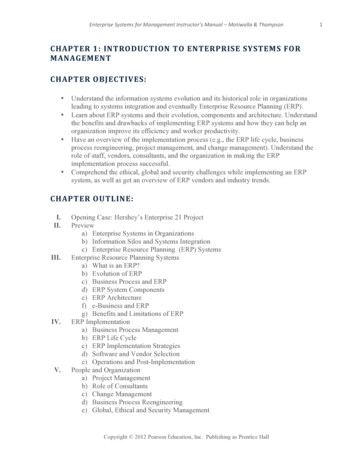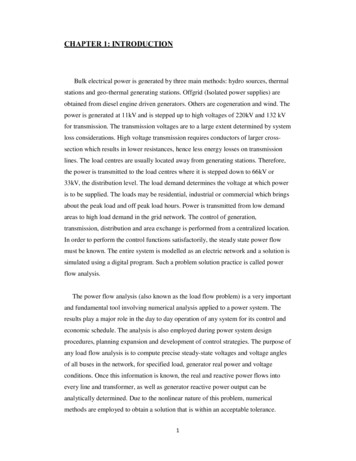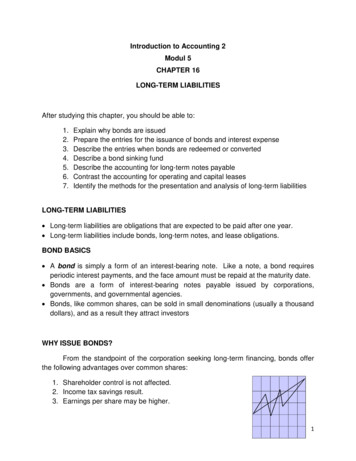
Transcription
1From Eckert, Penelope and McConnellGinet, Sally. (To appear). Language andGender. Second Edition. Cambridge andNew York: Cambridge University Press.CHAPTER 1: AN INTRODUCTION TO GENDERWe are surrounded by gender lore from the time we are very small. It is ever-present inconversation, humor, and conflict, and it is called upon to explain everything from driving stylesto food preferences. Gender is embedded so thoroughly in our institutions, our actions, ourbeliefs, and our desires, that it appears to us to be completely natural. The world swarms withideas about gender – and these ideas are so commonplace that we take it for granted that they aretrue, accepting common adage as scientific fact. As scholars and researchers, though, it is our jobto look beyond what appears to be common sense to find not simply what truth might be behindit, but how it came to be common sense. It is precisely because gender seems natural, and beliefsabout gender seem to be obvious truths, that we need to step back and examine gender from anew perspective. Doing this requires that we suspend what we are used to and what feelscomfortable, and question some of our most fundamental beliefs. This is not easy, for gender isso central to our understanding of ourselves and of the world that it is difficult to pull back andexamine it from new perspectives.1 But it is precisely the fact that gender seems self-evident thatmakes the study of gender interesting. It brings the challenge to uncover the process ofconstruction that creates what we have so long thought of as natural and inexorable – to studygender not as given, but as an accomplishment; not simply as cause, but as effect; and not just asindividual, but as social. The results of failure to recognize this challenge are manifest not onlyin the popular media, but in academic work on language and gender as well. As a result, somegender scholarship does as much to reify and support existing beliefs as to promote morereflective and informed thinking about gender.Sex and genderGender is not something we are born with, and not something we have, but something we do(West and Zimmerman 1987) – something we perform (Butler 1990). Imagine a small boyproudly following his father. As he swaggers and sticks out his chest, he is doing everything hecan to be like his father – to be a man. Chances are his father is not swaggering, but the boy iscreating a persona that embodies what he is admiring in his adult male role model. The same istrue of a small girl as she puts on her mother’s high-heeled shoes, smears makeup on her faceand minces around the room. Chances are that when these children are grown they will notswagger and mince respectively, but their childhood performances contain elements that maywell surface in their adult male and female behaviors. Chances are, also, that the girl will adopt1 This kind of stepping back is easier for people who feel that they are disadvantaged in the social order,and it is no doubt partially for this reason that many recent theories of gender have been developedprimarily (though not exclusively) by women.
2that swagger on occasion as well, but adults are not likely to consider it as cute as her mincingact. And chances are that if the boy decides to try a little mincing, he won’t be considered cute atall. In other words, gendered performances are available to everyone, but with them comeconstraints on who can perform which personae with impunity. And this is where gender and sexcome together, as society tries to match up ways of behaving with biologically based sexassignments.Sex is a biological categorization based primarily on reproductive potential, whereasgender is the social elaboration of biological sex. Not surprisingly, social norms for heterosexualcoupling and care of any resulting children are closely intertwined with gender. But that is farfrom the full story. Gender builds on biological sex, but it exaggerates biological difference, andit carries biological difference into domains in which it is completely irrelevant. There is nobiological reason, for example, why women should mince and men should swagger, or whywomen should have red toenails and men should not. But while we think of sex as biological andgender as social, this distinction is not clear-cut. People tend to think of gender as the result ofnurture – as social and hence fluid – while sex is the result of nature, simply given by biology.However, nature and nurture intertwine, and there is no obvious point at which sex leaves off andgender begins.But the sharp demarcation fails because there is no single objective biological criterionfor male or female sex. Sex is based in a combination of anatomical, endocrinal andchromosomal features, and the selection among these criteria for sex assignment is based verymuch on cultural beliefs about what actually makes someone male or female. Thus the verydefinition of the biological categories male and female, and people’s understanding ofthemselves and others as male or female, is ultimately social. Anne Fausto-Sterling (2000) sumsup the situation as follows:labeling someone a man or a woman is a social decision. We may use scientific knowledge tohelp us make the decision, but only our beliefs about gender – not science – can define our sex.Furthermore, our beliefs about gender affect what kinds of knowledge scientists produce aboutsex in the first place. (p. 3)Biology offers up dichotomous male and female prototypes, but it also offers us manyindividuals who do not fit those prototypes in a variety of ways. Blackless et al. (2000) estimatethat 1 in 100 babies are born with bodies that differ in some way from standard male or female.These bodies may have such conditions as unusual chromosomal makeup (e.g., 1 in 1,000 malebabies are born with two X chromosomes as well as a Y, hormonal differences such asinsensitivity to androgens (1 in 13,000 births), or a range of configurations and combinations ofgenitals and reproductive organs. The attribution of intersex does not end at birth – for example,1 in 66 girls experience growth of the clitoris in childhood or adolescence (known as late onsetadrenal hyperplasia).When “anomalous” babies are born, surgical and/or endocrinal manipulations may beused to bring their recalcitrant bodies into closer conformity with either the male or the femalecategory. Common medical practice imposes stringent requirements for male and female genitals
3at birth – a penis that is less than 2.5 centimeters long when stretched, or a clitoris2 that is morethan one centimeter long have commonly been subject to surgery in which both are reduced to an“acceptable” sized clitoris (Dreger 1998). As a number of critics have observed (e.g. Dreger1998), the standards of acceptability are far more stringent for male genitals than female, andthus the most common surgery transforms “unacceptable” penises into clitorises, regardless ofthe child’s other sexual characteristics, and even if this requires fashioning a nonfunctionalvagina out of tissue from the colon. In recent years, the activist organization, the Intersex Societyof North America,3 has had considerable success as an advocacy group for the medical rights ofintersex people, and the medical profession has become more sensitive to both physical andpsychological issues associated with gender assignment and surgery (e.g. Lee et al 2006).In those societies that have a greater occurrence of certain kinds of hermaphroditic orintersexed infants than elsewhere,4 there sometimes are social categories beyond the standardtwo into which such babies can be placed. But even in such societies, categories that go beyondthe basic two are often seen as anomalous.5 And even where sex assignment seemed2 Alice Dreger (1998) more accurately describes these as a “phallus on a baby classified as male” or a“phallus on a baby classified as female”.3 The website of the Intersex Society of North America (http://www.isna.org) offers a wealth ofinformation on intersex. [The publisher has used its best endeavors to ensure that the URLs for externalwebsites referred to in this book are correct and active at the time of going to press. However, thepublisher has no responsibility for the websites and can make no guarantee that a site will remain live orthat the content is or will remain appropriate.]4 For instance, congenital adrenal hyperplasia (which combines two X chromosomes with masculinizedexternal genitalia and the internal reproductive organs of a potentially fertile woman) occurs in 43children per million in New Zealand, but 3,500 per million among the Yupik of Southwestern Alaska(www.isna.org).5 There are cultures where what we might think of as more than two adult gender categories are namedand otherwise institutionally recognized as well: the berdache of the Plains Indians, the hijras in India.Although details vary significantly, the members of such supernumerary categories are outside the“normal” order of things, and tend to be somewhat feared or devalued or otherwise sociallydisadvantaged. Nonetheless, there is apparently considerably more tolerance for nonstandard gendercategories in some societies than in the western industrial societies most likely to be familiar to readers of
4straightforward at birth, an individual may develop a gender identity different from the oneinitially assigned on the basis of anatomical criteria. Transgender people may embrace the otherof the two options standardly on offer or they may resist gender dichotomies altogether. KateBornstein, a trans woman who finds gender deeply problematic, sums up this resistance nicely inher 1995 book title, Gender Outlaw: On Men, Women and the Rest of Us1.It is commonly argued that biological differences between males and females determinegender by causing enduring differences in capabilities and dispositions. Higher levels oftestosterone, for example, are said to lead men to be more aggressive than women; and left-braindominance is said to lead men to be more rational while their relative lack of brain lateralizationshould lead women to be more emotional. But the relation between physiology and behavior isnot simple, and it is all too easy to leap for gender dichotomies. And the physiology itself is morecomplex than is usually acknowledged. It has been shown that hormonal levels, brain activitypatterns, and even brain anatomy can be a result of different activity as well as a cause. Forexample research with species ranging from rhesus monkeys (Rose et al. 1972) to fish (Fox et al.1997) has documented changes in hormone levels as a result of changes in social position.Work on sex differences in the brain is very much in its early stages, and is far fromconclusive (Fausto-Sterling 2000). Men’s supposedly smaller corpus callosum, larger amygdala,larger premammillary nucleus, are among the questionable structural differences that aresupposed to account for gender differences from men’s greater visual-spatial skills to theirtendency to stare at breasts2. Much of the popular work on gender differences in the brain arebased on shaky evidence, and are commonly exaggerations and even distortions of what appearsin the scientific literature. And the scientific literature itself is based on very small samples, oftenfrom sick or injured populations. In addition, not that much is known about the connectionsbetween brain physiology and behavior or cognition – hence about the consequences of anyphysiological differences scientists may be seeking or finding. And above all, the brain is veryplastic, changing in response to experience. Thus the causal relation between brain physiologyand activity is completely unclear (Eliot 2009). Nonetheless, any results that might supportphysiological differences are readily snatched up and combined with any variety of genderstereotypes in some often quite fantastic leaps of logic. And the products of these leaps can inturn feed directly into social, and particularly into educational, policy, with arguments thatgender equity in such “left-brain areas” as mathematics and engineering is impossible.(For additional critiques of sex difference science, see Kaplan & Rogers 2003), Fine2010), and Jordan-Young 2010). Deborah Cameron (2009) refers to the search for genderdifferences in biology as “the new biologism”, and points out that the linguistic traits thatscientists are trying to explain biologically (such as women’s greater language ability) are noteven themselves supported by serious linguistic study. Furthermore, those pushing forthis book. An early discussion of social groups with more than two sex and/or gender categories isprovided by Martin and Voorhies (1975), ch. 4, “Supernumerary sexes.” More recent contributions on thistopic from both historical and cross-cultural perspectives appear in Herdt (1996).1See also Bornstein 1998 and Bornstein & Bergman, eds. 2010.Mark Liberman has a series of blogs on shaky brain science - see e.g.http://languagelog.ldc.upenn.edu/nll/?p 2208;http://languagelog.ldc.upenn.edu/nll/?p 25762
5biologically based explanations of sex differences ignore the fact that the very same linguisticdifferences that they see beetween the genders also correlate with race and social class, and manyof the sex differences they cite as biologically based actually vary historically and crossculturally (e.g. Keenan 1974; Kulick 1993,1994).The eagerness of some scientists to establish a biological basis for all gender difference,and the public’s eagerness to take these findings up, points to the fact that we put a good deal ofwork into emphasizing, producing, and enforcing the dichotomous categories of male andfemale. In the process, differences or similarities that blur the edges of these categories, or thatmight even constitute other potential categories, are backgrounded, or erased, including theenormous range of differences among females and among malesThe issue here is not whether there are sex-linked biologi
Sex and gender Gender is not something we are born with, and not something we have, but something we do (West and Zimmerman 1987) – something we perform (Butler 1990). Imagine a small boy proudly following his father. As he swaggers and sticks out his chest, he is doing everything he can to be like his father – to be a man. Chances are his father is not swaggering, but the boy is creating .











